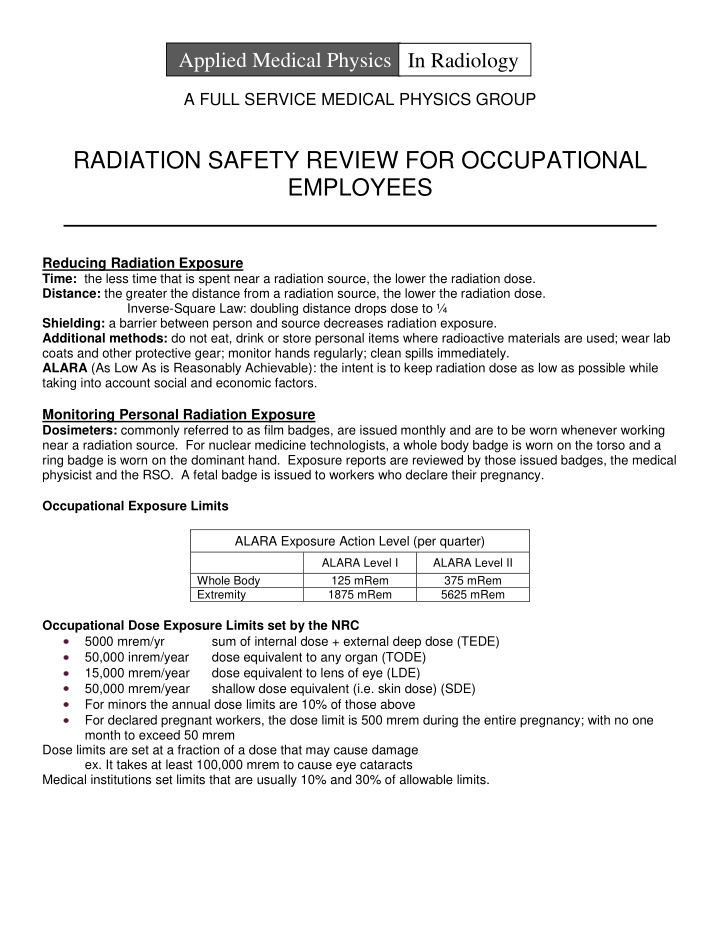



Applied Medical Physics In Radiology A FULL SERVICE MEDICAL PHYSICS GROUP RADIATION SAFETY REVIEW FOR OCCUPATIONAL EMPLOYEES Reducing Radiation Exposure Time: the less time that is spent near a radiation source, the lower the radiation dose. Distance: the greater the distance from a radiation source, the lower the radiation dose. Inverse-Square Law: doubling distance drops dose to ¼ Shielding: a barrier between person and source decreases radiation exposure. Additional methods: do not eat, drink or store personal items where radioactive materials are used; wear lab coats and other protective gear; monitor hands regularly; clean spills immediately. ALARA (As Low As is Reasonably Achievable): the intent is to keep radiation dose as low as possible while taking into account social and economic factors. Monitoring Personal Radiation Exposure Dosimeters: commonly referred to as film badges, are issued monthly and are to be worn whenever working near a radiation source. For nuclear medicine technologists, a whole body badge is worn on the torso and a ring badge is worn on the dominant hand. Exposure reports are reviewed by those issued badges, the medical physicist and the RSO. A fetal badge is issued to workers who declare their pregnancy. Occupational Exposure Limits ALARA Exposure Action Level (per quarter) ALARA Level I ALARA Level II Whole Body 125 mRem 375 mRem Extremity 1875 mRem 5625 mRem Occupational Dose Exposure Limits set by the NRC 5000 mrem/yr sum of internal dose + external deep dose (TEDE) 50,000 inrem/year dose equivalent to any organ (TODE) 15,000 mrem/year dose equivalent to lens of eye (LDE) 50,000 mrem/year shallow dose equivalent (i.e. skin dose) (SDE) For minors the annual dose limits are 10% of those above For declared pregnant workers, the dose limit is 500 mrem during the entire pregnancy; with no one month to exceed 50 mrem Dose limits are set at a fraction of a dose that may cause damage ex. It takes at least 100,000 mrem to cause eye cataracts Medical institutions set limits that are usually 10% and 30% of allowable limits.
Radiation Areas Unrestricted Areas: access is not limited; radiation levels are less than 2mrem/hr Restricted Areas: access is limited to authorized personnel; appropriate signage is used to designate restricted area; locking door is present. Caution: Radioactive Materials – area in which radioactive materials are used or stored Caution: Radiation Area – area in which an individual may receive more than 5 mrem/hr Caution: High Radiation Area – area in which an individual may receive more than 100 mrem/hr Regulations require that regular wipes and surveys be conducted of these areas. Area Surveys and Wipes Ensure that survey meter is operating properly and has current calibration. For survey: perform at the end of each day of use or if contamination is suspected; For wipe: perform once a week or if contamination is suspected Record readings on appropriate hot lab form and maintain for 3 years Trigger levels for area surveys: restricted area – 5.0 mR/hr; unrestricted 0.1 mR/hr Trigger levels for area wipe: restricted area – 2200 dpm/100cm 2 Unrestricted area – 300 dpm/100cm 2 Package Surveys Survey must be performed within 3 hours of receipt or department opening Visually inspect package for visual damage Survey all sides of package at surface and 1 meter, when applicable When required, wipe 300 cm 2 of package and count wipe; cannot be >22 dpm/cm 2 Record findings on appropriate form If you receive a package that is contaminated, you are to contact your RSO immediately; or if a package is lost, you are to contact your RSO immediately. DOT labels Label Surface Radiation Transport Index Level (mrem/hr) (1 Meter) White Up to 0.5 N/A I Yellow >0.5 – 50 >0 – 1.0 II Yellow >50 – 200 >1 - 10 III
Spills Procedures Minor Spills of Liquids or Solids 1. Notify persons in the area that a spill has occurred. 2. Prevent the spread of contamination by covering the spill with chux. 3. Wearing gloves and protective clothing, clean up the spill using chux. Place contaminated items into ba g labeled “caution radioactive material” and store in a radioactive waste container. 4. Survey the area with a survey meter to ensure contamination levels are below trigger levels. Check the area around the spill. Also check hands, clothing and shoes for contamination. 5. Report to incident to the RSO. Major Spills of Liquids and Solids 1. Clear the area. Notify all persons not involved in the spill to vacate the room. 2. Prevent the spread of contamination by covering the spill with “caution radioactive material” l abeled chux, but do not attempt to clean it up. Clearly designate the boundaries of the spill and limit the movement of all personnel who may be contaminated. 3. Shield the source if possible. Close the room off from traffic. 4. Notify the RSO immediately. 5. Decontaminate personnel by removing contaminated clothing and flushing contaminated skin with lukewarm water, then washing with mild soap. If contamination remains, the RSO may consider inducing perspiration. Then wash the affected area again to remove any contamination that was released by the perspiration. The Jameson Health System’s Radiation Safety Officer (RSO) is Robert Ondo. He can be reached by calling 724-656-4123 or the Hospital Operator.
Recommend
More recommend